On a day threatening rain I drove into downtown Denver for a visit to the museum. Since I had already toured a couple battlefields, what caught my eye was a special exhibit on the "Buffalo Soldiers"--what the Indians called the black US cavalrymen. Sadly, I was a day late for the exhibit, but fortunately, most of it was still up--the only parts that seemed to have been taken down were the mannikins.
The staircase brings you down a floor to the special exhibit. A Buffalo Soldier would have greeted you, but alas, all I saw was the horse.
Large Photo of Cavalry Horse (slow: 166K)
Barracks included a separate room, with desk, for the sergeant.
Soldiers from the black cavalry and infantry regiments, plus Seminole-Negro Scouts, earned the Medal of Honor for their bravery during the Pony Wars.
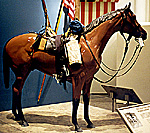 The museum is a huge facility, and when you figure that mining helped make this town, it needed the space to display the equipment. But I get ahead of myself.
The museum is a huge facility, and when you figure that mining helped make this town, it needed the space to display the equipment. But I get ahead of myself.
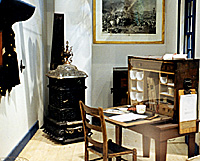
 Entering the main hall, a recreation of soldiers' barracks showed how they lived, at least when they weren't outside the forts.
Entering the main hall, a recreation of soldiers' barracks showed how they lived, at least when they weren't outside the forts.
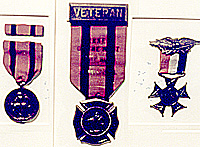 Next was a room recognizing the various achievements of the Buffalo Soldiers, including earning Indian Wars medals (at right). Left: Campaign medal, Center: Veterans medal, Right: Army-Navy Union Medal.
Next was a room recognizing the various achievements of the Buffalo Soldiers, including earning Indian Wars medals (at right). Left: Campaign medal, Center: Veterans medal, Right: Army-Navy Union Medal.
9th US Cavalry
Sgt. John Denny Corp. Clinton Greaves Sgt. Henry Johnson Sgt. George Jordon Sgt. Thomas Shaw Sgt. Emmanual Stance Pvt. Augustus Walley 1st Sgt. Moses Williams |
10th US Cavalry
24th US Infantry
Seminole-Negro Scouts
Pvt. Adam Paine Pvt. Isaac Payne Pvt. John Wood |
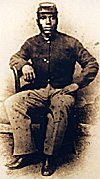 Reuben Waller
Reuben Waller
Reuben Waller rode in Company H of the 10th Cavalry back in 1869. Company H and I formed a command that helped rescue Col. George A. Forsyth and his party of civilian scouts besieged at Beecher's Island. Beecher's Island Battlefield.
Waller noted, upon reaching the battlefield: "There went up a cheer that made the valley ring, and strong men grasped hands, and then flung their arms around each other, and laughed and cried."
Equipment
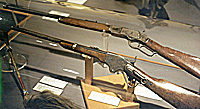 Further along, in another room which appears more like a permanent display than part of the special Buffalo Soldiers exhibit, is a variety of equipment and accountrements of cavalrymen and Indians.
Further along, in another room which appears more like a permanent display than part of the special Buffalo Soldiers exhibit, is a variety of equipment and accountrements of cavalrymen and Indians.
For example, in the photo at right, two of the firearms used were the Spencer Repeating Carbine (bottom) and the Winchester model 1873 rifle (top). An Indian club is at left.
At right, Indian shirt and shield.
At left, bow, arrows, and quiver.
Large Photo of Indian shirt and shield (slow: 153K)
It belonged to Sgt. John Howland of the 1st Colorado Cavalry (1862-1864).
Also inside is a US model 1860 light cavalry sabre and a McClelland saddle.
Other Parts of the Museum
That ended the section of the museum displaying uniforms and equipment. The rest of the museum is well worth taking a walk through.
Along the way are all sorts of "Americana" including clothing, utensils, and other day-to-day objects exploring the life and culture of the American West in General, and Colorado in particular.
The Museum offers a gift shop, as well as a research library for Old West material.
A local museum is housed in the Byers-Evans House, two blocks from the Museum at the corner of 13th and Bannock. I purchased a combination ticket so I could go into both museums--it saves you a couple dollars.
Run by local volunteers, you receive a guided tour throughthe home, which displays the home as it would have looked in the late 1800s. William Byers, publisher of the Rocky Mountain News, built the home in 1883 and sold it in 1889 to the family of William Evans, an officer of the Denver Tramway Company. There is a short film, and all told, the tour takes about an hour as they lead you through living room, kitchen, bedrooms, and more. The staff is knowledgeable, and deservedly proud of mainitaining the residence in pristine shape.
Colorado History Museum Colorado History Museum is a long block from Civic Center Park at the corner of 13th and Broadway.
Trianon Museum and Art Gallery (Denver, CO)

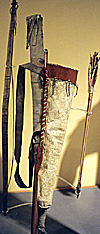 Although the Indians certainly used rifles, they were also armed with bows.
Although the Indians certainly used rifles, they were also armed with bows.
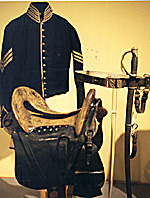 Another display case contains an enlisted man's cavalry jacket.
Another display case contains an enlisted man's cavalry jacket.
 A huge diorama of Denver as it appeared in 1860 is quite well done. A huge area, criss-crossed with ramps and catwalks, shows off a wide variety of mining equipment. A timeline is very clever in showing the progression of Colorado events from the formation of Earth to the present day.
A huge diorama of Denver as it appeared in 1860 is quite well done. A huge area, criss-crossed with ramps and catwalks, shows off a wide variety of mining equipment. A timeline is very clever in showing the progression of Colorado events from the formation of Earth to the present day.
 A uniform of the Colorado National Guard is in a dimly lit place, so the colors in the photo at right are a bit diluted. The uniform consists of dark blue pants with a grey stripe with white trim along the side of the legs. A midinght blue jacket with black edging has slate blue epaulettes with gold trim. A midnight blue hat has a slate blue band, gold edging, and a gold eagle ornament.
A uniform of the Colorado National Guard is in a dimly lit place, so the colors in the photo at right are a bit diluted. The uniform consists of dark blue pants with a grey stripe with white trim along the side of the legs. A midinght blue jacket with black edging has slate blue epaulettes with gold trim. A midnight blue hat has a slate blue band, gold edging, and a gold eagle ornament.
Denver History Museum
On the War Trail
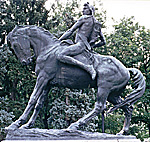 As you're walking about, do enter the park for a quick look around. You'll find a 1922 statue by Stephen Knight called "On the War Trail."
As you're walking about, do enter the park for a quick look around. You'll find a 1922 statue by Stephen Knight called "On the War Trail."
1330 Broadway
Denver, Colorado 80203
303-866-3682
Open Mon-Sat, 10am-4:30pm, Sun 12 noon-4:30pm
Admission: $5.
Back to List of Historic Sites
Back to Travel Master List
Back to MagWeb Master List of Magazines
© Copyright 1998 by Coalition Web, Inc.
This article appears in MagWeb (Magazine Web) on the Internet World Wide Web.
Other military history articles and gaming articles are available at http://www.magweb.com